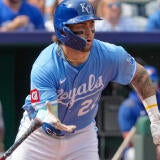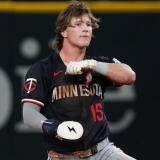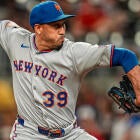By the Numbers: Coming to a close
Pinpointing exactly who will rack up saves in a given season is always a tricky proposition. Our Al Melchior examines some recent historical trends to predict who might be the next Joakim Soria or Brad Ziegler in his By the Numbers.
If you think about it, Brad Ziegler is a little like Barack Obama. Our President-Elect does not have a sidearm delivery. No, what I am thinking of are the unorthodox paths each has taken to their recently anointed positions. Obama became the first sitting U.S. Senator to become President since John F. Kennedy. (Of course, the same would have been true for John McCain.) When A's skipper Bob Geren made Ziegler his closer last August, he became the only Class of '08 rookie to ultimately earn 10 or more saves. Not only was he the only rookie among the 37 pitchers with at least 10 saves, but he was the only one who was not a major league reliever the previous season. That's a career path as narrow as the road that has been paved from Governors' mansions to the White House in recent decades.
This may seem like an arcane piece of baseball trivia, but it shows us something about where Fantasy owners have been finding the best sources for saves. Over the last several years, the best place to find Fantasy relievers has been the saves leaderboards from previous seasons. Of the 37 top save-producers in 2008, 28 of them had saved at least 10 games in a prior campaign. In other words, most closers are experienced closers.
Of course, that hardly qualifies as a news flash. Mariano Rivera has been good for 30 or more saves for 11 out of the last 12 years, and it seems pretty safe to pencil him in for 12 out of 13. The more interesting and useful piece of information is that, while 76 percent of last year's closers were experienced, 24 percent of were inexperienced. Since the 2000 season, that figure has been 29 percent. That means, on average, that there have been 10 or 11 closers each season this decade who never had a long-standing ninth-inning gig before.
If 2008 was any indication, the clear path to closerdom must go through the front or middle of a big league bullpen, rather than through the starting rotation (as John Smoltz once went) or a minor league pitching staff. However, going back to 2000, barely more than half of the new closers trained for the job as major league relievers. The remainder of the group consisted mainly of failed starters, such as Eric Gagne and LaTroy Hawkins, and rookies catapulted into the closer's role shortly after their arrival in the majors, and most fall into this latter category.
The arrival of many rookie pitchers is highly anticipated -- recall the mania in Fantasy leagues over David Price and Gio Gonzalez that started weeks before their respective callups -- but, as in these two cases, the biggest hype is almost always reserved for starting pitchers. But how many Fantasy owners can say that they foresaw the emergence of Ziegler in '08 or Joakim Soria in '07? Even those who track the minors closely would have had a hard time picking either one of them as the Next Big Closing Thing. Soria had little minor league experience, and the soft-tossing Ziegler just didn't fit the normal profile.
Ziegler aside, there is a common statistical profile among most of the pitchers from this decade who have become closers in their rookie seasons. Since 2000, there have been 23 rookies who have claimed the closer's role and saved at least 10 games during their first year in the majors. Minor league stats for these pitchers from the season before their rookie year are listed below. The common threads are, not surprisingly, high strikeout rates, often in excess of a batter per inning, closing experience at Double-A or Triple-A, and reaching the majors by their 25th birthday. Solid command of the strike zone is not a prerequisite, as closers like Jose Valverde, Bobby Jenks and Brian Bruney nabbed the job as rookies despite BB/9 rates above 4.0 in the minors less than a year earlier. A few of these rookie closers, including Jonathan Papelbon and Greg Aquino, were converted starters, but they have been the exceptions.
| Closer |
Year before rookie season |
Age | Level | Starts | Saves | IP | BB/9 | K/9 | K/BB |
| Brad Ziegler | 2007 | 27 | Triple-A | 0 | 1 | 54.7 | 2.3 | 7.2 | 3.1 |
| Bobby Jenks | 2005 | 24 | Double-A | 0 | 19 | 41 | 4.4 | 10.5 | 2.4 |
| Chris Ray | 2005 | 23 | Double-A | 0 | 18 | 37.3 | 1.7 | 9.7 | 5.7 |
| Jonathan Papelbon | 2005 | 24 | Double-A | 14 | 0 | 87 | 2.4 | 8.6 | 3.6 |
| Yhency Brazoban | 2004 | 24 | Double-A | 0 | 13 | 51 | 3.9 | 10.8 | 2.8 |
| Brian Bruney | 2004 | 22 | Triple-A | 0 | 5 | 38 | 4.7 | 9.9 | 2.1 |
| Jason Frasor | 2003 | 25 | Double-A | 0 | 17 | 37 | 3.4 | 12.2 | 3.6 |
| Greg Aquino | 2003 | 25 | Double-A | 20 | 0 | 107 | 3.2 | 7.7 | 2.4 |
| Jose Valverde | 2002 | 22 | Triple-A | 0 | 5 | 48 | 4.3 | 12.2 | 2.8 |
| Aquilino Lopez | 2002 | 27 | Triple-A | 11 | 5 | 109 | 2.2 | 8.5 | 3.8 |
| Lance Carter | 2002 | 27 | Triple-A | 18 | 1 | 132 | 0.8 | 6.1 | 7.5 |
| Mike MacDougal | 2002 | 25 | Triple-A | 10 | 0 | 53 | 9.3 | 5.1 | 0.5 |
| Jorge Julio | 2001 | 22 | Triple-A | 0 | 12 | 43 | 4.0 | 10.0 | 2.5 |
| Damaso Marte | 2001 | 26 | Double-A | 0 | 1 | 36 | 1.8 | 9.0 | 5.1 |
| Scott Stewart | 2000 | 24 | Triple-A | 1 | 5 | 72 | 2.3 | 7.1 | 3.2 |
| Byung-Hyun Kim | 1999 | 20 | Triple-A | 3 | 1 | 30 | 4.5 | 12.0 | 2.7 |
| Ryan Kohlmeier | 1999 | 22 | Double-A | 0 | 23 | 63 | 4.1 | 11.1 | 2.7 |
Despite Ziegler being the only rookie closer in '08 to hold down the job for a substantial period of time, recent history tells us that we can expect as many as four rookies to be a reliable source of saves in any given season. Here are seven candidates who could qualify for that status in '09. Each posted an exceptional strikeout rate last season while putting in some time as his team's closer. With the exception of Kevin Hart, all will be 25 years old or younger this coming season.
| Pitcher | Organization | Age | Level | Starts | Saves | IP | BB/9 | K/9 | K/BB |
| Daniel Bard | Boston | 23 | Double-A | 0 | 7 | 49.7 | 4.7 | 11.6 | 2.5 |
| Kevin Hart | Chicago Cubs | 25 | Triple-A | 10 | 5 | 57.7 | 3.1 | 9.8 | 3.2 |
| Sammy Gervacio | Houston | 23 | Double-A | 0 | 5 | 65.3 | 3.6 | 11.3 | 3.2 |
| Jesse Chavez | Pittsburgh | 24 | Triple-A | 0 | 14 | 68.7 | 2.9 | 9.2 | 3.2 |
| Luke Gregerson | St. Louis | 24 | Double-A | 0 | 10 | 75.3 | 3.1 | 9.3 | 3.0 |
| Fernando Salas | St. Louis | 23 | Double-A | 0 | 25 | 74 | 2.0 | 12.2 | 6.3 |
| Shawn Kelley | Seattle | 24 | Double-A | 0 | 9 | 42.7 | 3.6 | 9.3 | 2.6 |
Luke Gregerson and Fernando Salas are the most intriguing possibilities from this list due to the Cards' murky closer situation. There could be a number of rookie candidates, but Gregerson and Salas are younger than Jason Motte and Mark Worrell. Both have also exhibited much better control than Chris Perez, who just missed achieving rookie status in '08 while racking up seven big league saves.
Matt Capps and J.J. Putz are settled in as the closers in Pittsburgh and Seattle, but both could be mid-season trade bait for their rebuilding franchises. If the Mariners fail to contend, they would have a strong incentive to shed Putz and his $8.6 million team option for 2010 and give Shawn Kelley a chance. If the Pirates let Capps go, Jesse Chavez is looking more and more like the heir apparent, especially after Craig Hansen's failed tryout (three saves in seven opportunities) this past year.
The closer situations in Boston and Houston are as stable as they are anywhere, so unless they are traded, Daniel Bard and Sammy Gervacio will have to wait their turn. Still, it's worth making a mental note of both in case saves opportunities avail themselves, as both exhibited K/9 rates in excess of 11.0 this past year. Likewise, Carlos Marmol and Kevin Gregg are at the head of the Cubs' line for saves, but Kevin Hart lurks as a possible third option.
As draft time approaches, your best chance to bolster your saves total is still to target known quantities. The prospects highlighted here, though they may remain under the radar come Spring Training, and therefore, are unlikely to make your competitors' draft lists, deserve a spot on your Scout Team. In deep or prospect-savvy leagues, you may want to dip into this short list to fill your final pitching reserve slot. The upside of closer prospects like Salas and Chavez may put you in a better position long term than if you settle for a more typical endgame pick like Matt Lindstrom or Jensen Lewis. Either way, keep an eye on these potential closers and be prepared to roster them if save opportunities appear imminent for them.
|
|
|
Runs Created per 27 Outs (RC/27) -- An estimate of how many
runs a lineup would produce per 27 outs if a particular player
occupied each spot in the order; ex. the RC/27 for Miguel Cabrera
would predict the productivity of a lineup where Cabrera (or his
statistical equal) batted in all nine spots; created by Bill James Component ERA (ERC) -- An estimate of a what a pitcher's ERA would be if it were based solely on actual pitching performance; created by Bill James Base Hits per Balls in Play (H/BIP) -- The percentage of balls in play (at bats minus strikeouts and home runs) that are base hits; research by Voros McCracken and others has established that this rate is largely random and has a norm of approximately 30% Isolated Power -- The difference between slugging percentage and batting average; created by Branch Rickey and Allan Roth Walk Rate -- Walks / (at bats + walks) Whiff Rate -- Strikeouts / at bats |
Al Melchior was recently a Fantasy columnist and data analyst for Baseball HQ and will be providing advice columns for CBSSports.com. Click here to send him a question. Please put "Melchior" in the subject field.
















